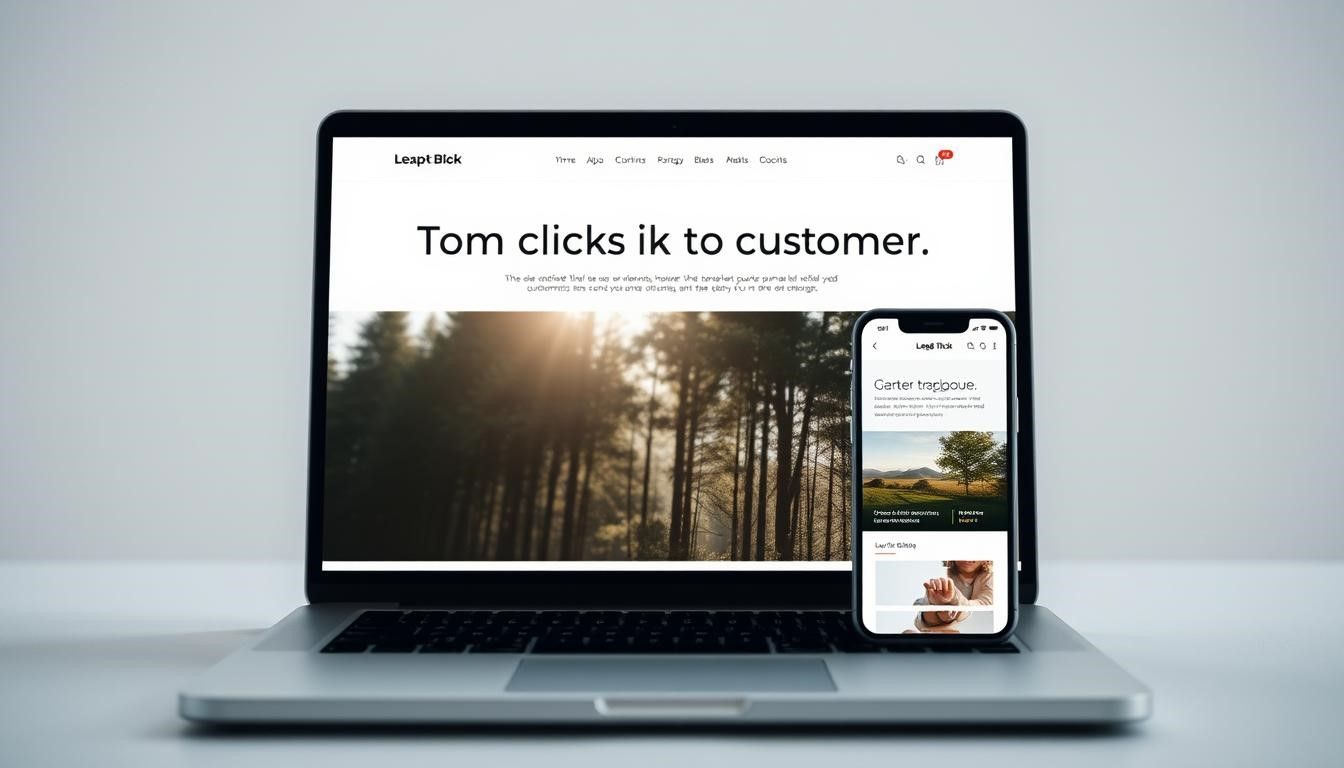The Importance of Mobile-First Web Design and How to Implement It
Imagine trying to read a website on your phone, but the text is tiny and you have to zoom in constantly. This frustrating experience happens when websites aren't built for mobile users first. With over 60% of web traffic coming from smartphones and tablets, ignoring mobile optimization means missing most of your audience.

The mobile-first design philosophy starts with creating websites for small screens. This approach ensures core features work perfectly on phones before expanding to larger devices. It's a complete shift from traditional methods that prioritized desktop computers.
At EZPages.Pro, we specialize in helping businesses succeed online. Our team designs, maintains, and hosts websites with a focus on mobile optimization. We handle all the technical details so companies can concentrate on growth.
This strategy leads to better overall websites. Starting with mobile constraints forces cleaner layouts and faster loading times. The result is an excellent experience for all visitors, regardless of their device.
Adopting a
responsive design approach ensures your site looks great everywhere. It automatically adjusts to different screen sizes without losing functionality. This flexibility is crucial in today's mobile-dominated world.
Key Takeaways
- Over 60% of web traffic comes from mobile devices
- Mobile-first design prioritizes smartphone users from the start
- This approach leads to cleaner, faster-loading websites
- Responsive design ensures proper display on all screen sizes
- EZPages.Pro specializes in mobile-optimized website solutions
- Proper mobile optimization improves customer engagement
- Starting with mobile constraints creates better overall user experiences
Introduction to Mobile-First Web Design
The digital landscape has fundamentally shifted. Smartphones and tablets now generate over 64% of all global web traffic. This means the majority of your potential customers are browsing on a small screen.
This change demands a new approach to building websites. Starting with the desktop experience is no longer the most effective strategy.
Why Mobile-First Matters in Today's Digital Landscape
Search engines like Google have adapted to this reality. They now use mobile-first indexing. This means Google primarily uses the mobile version of your site for ranking and indexing. If your site isn't optimized for phones, your search visibility suffers.
User behavior reinforces this priority. The average person spends more than three hours daily on their phone. They check their device nearly 60 times each day.
Ignoring these trends risks losing more than half of your audience. It also puts you behind competitors who prioritize a seamless
user experience for all visitors.
A true mobile-first strategy isn't about shrinking a desktop site. It's about reimagining your digital presence around the needs of people on the go. This focus leads to better engagement and higher conversion rates.
At EZPages.Pro, we help businesses navigate this mobile-dominated world. We create tailored solutions that ensure your website connects effectively with every customer, on every device.
Understanding the Mobile-First Design Approach
Building a website used to mean starting with a large canvas, but the rise of smartphones flipped the script entirely. This new reality required a fresh design approach.
The core idea is simple yet powerful. It fundamentally changes how we think about creating online experiences.
Core Concepts and Evolution from Desktop-First
Originally, websites were built for desktop computers. Designers had ample space for complex layouts and numerous features.
When adapting these sites for smaller screens, they used a method called
graceful degradation. This involved stripping away elements to make things fit.
Unfortunately, this often resulted in a poor experience on mobile devices. Key functions were sometimes lost or became difficult to use.
A better method emerged known as
progressive enhancement. It is the opposite of graceful degradation.
You start by creating a solid, fast experience for the smallest screens. Then, you add more features as screen size increases.
This philosophy ensures your site's core content is accessible to everyone, regardless of their device. It is the heart of the
mobile-first approach.
User Behavior and Mobile Traffic Trends
The data makes this shift non-negotiable. Global internet traffic from mobile devices has decisively surpassed desktop usage.
People now expect instant access to information from their phones. They browse in short bursts, looking for quick answers.
Designing for these smaller screens first forces a focus on what truly matters. It leads to cleaner layouts and faster load times for all users.
Benefits of Adopting a Mobile-First Design Strategy
Starting your website creation process with mobile devices in mind delivers concrete rewards that impact both users and search engines. This approach transforms how people interact with your content while boosting your online visibility.
Enhanced User Experience and Seamless Navigation
Building for small screens first forces you to prioritize what truly matters. You eliminate clutter and focus on essential features that customers need most.
This creates a cleaner, more intuitive
user experience. Visitors can find information quickly without frustrating zooming or scrolling. The simplified navigation works beautifully
across devices of all sizes.
Improved Mobile SEO and Faster Load Times
Google's mobile-first indexing means your phone-optimized site gets priority in search results. A proper mobile design strategy aligns perfectly with these ranking factors.
Streamlined code and optimized images lead to dramatically faster
load times. Since 53% of mobile users abandon slow sites, this improvement directly reduces bounce rates. Better performance means more engaged visitors.
At EZPages.Pro, we handle the technical optimization so businesses can focus on growth. Our comprehensive services ensure your website leverages all these advantages without the complexity.
Implementing Mobile-First Design Principles
Effective mobile implementation starts with understanding what truly matters to users on smaller screens. This approach requires careful planning and strategic execution.
Prioritizing Content and Visual Hierarchy
When adopting a mobile-first design strategy, you must prioritize content ruthlessly. Identify which information serves immediate user needs. Everything else can wait for larger screens.
Creating a clear
visual hierarchy guides users to
important elements first. Use size, color, and spacing to highlight primary actions like "Buy Now" or "Contact Us." These should be visible without scrolling.
Optimizing Touch-Friendly Elements and Load Performance
Interactive elements require special attention on mobile devices. Apple recommends touch targets of at least 44 pixels square. This prevents frustrating mis-taps.
Proper spacing between
interitive elements is equally crucial. Avoid hover effects entirely since they don't work on touchscreens.
| Element Type | Minimum Size | Recommended Spacing | 12px vertical space |
|---|---|---|---|
| Buttons | 44px × 44px | 8px minimum | Clear visual feedback |
| Navigation Links | 44px height | 16px between items | Easy thumb reach |
| Form Fields | 44px height | 12px vertical space | Ample touch area |
"The best mobile experiences feel intuitive from the first touch. They understand that fingers need space and immediate feedback."
Performance optimization completes your mobile-first design implementation. Use responsive images and minimize JavaScript for faster loading. This ensures smooth experiences even on slower connections.
Best Practices for Responsive Website Design
In today's multi-device world, your website needs to adapt gracefully to every screen it encounters. A proper responsive design strategy ensures your content looks perfect whether viewed on a smartphone, tablet, or desktop monitor.
Designing for Different Screen Sizes
Start by prioritizing your most important content. Space is precious on smaller screens, so focus on what users need immediately. This approach creates a clean, focused experience across all different screen sizes.
Navigation should be intuitive and accessible. Consider using hamburger menus or navigation drawers for secondary options. These elements keep your interface clean while maintaining full functionality.
Avoid disruptive pop-ups that frustrate mobile users. Google penalizes intrusive interstitials, and they're particularly annoying on small
screen sizes where dismissal is difficult.
Use fluid grids and flexible images that scale naturally. CSS media queries help your layout adjust at specific breakpoints. Let your content determine these breakpoints rather than targeting specific devices.
Testing on real devices is essential. Emulators can't replicate real-world conditions like touch interactions and network speeds. Regular testing ensures optimal performance across all
screen size variations.
Adopting these
responsive design principles creates websites that work beautifully everywhere. Your visitors will appreciate the consistent, user-friendly experience regardless of their device choice.
Tools and Resources for Mobile Optimization
The quality of your mobile experience depends heavily on the tools you choose for design and testing. Having the right resources streamlines development and ensures your site performs beautifully everywhere.

Modern platforms like Figma and Adobe XD excel at prototyping responsive layouts. These collaborative tools help teams visualize how content adapts to various screen sizes.
Recommended Design and Prototyping Tools
Frameworks like Bootstrap and Foundation provide pre-built components for rapid development. They follow mobile-first design principles, ensuring your foundation works perfectly on phones.
Chrome DevTools offers powerful debugging capabilities. Its device emulator lets you preview how your site appears on different screen configurations before deployment.
Testing Across Devices for Real-World Performance
Google's Mobile-Friendly Test and PageSpeed Insights provide crucial performance feedback. They analyze loading times and identify optimization opportunities.
Platforms like BrowserStack enable comprehensive testing
across devices and browsers. However, nothing replaces testing on actual physical devices for authentic user experience validation.
Need expert help implementing these tools? Book an appointment at
https://www.ezpages.pro/book-appointment or call
(310) 421-0433 for professional mobile optimization assistance.
Comparing Mobile-First Design and Responsive Web Design
Many people confuse mobile-first and responsive design, but understanding their distinct roles is crucial for modern web development. They are complementary strategies, not interchangeable terms.
Think of it this way:
mobile-first design answers the question of
where you start building—with the smallest screen.
Responsive design describes
how your layout fluidly adapts to any screen size. You can have a responsive site that wasn't built with a mobile-first approach.
Progressive Enhancement vs. Graceful Degradation
Progressive enhancement is the philosophy behind a true mobile-first strategy. You build a solid, fast core experience for phones first. Then, you layer on more features and complexity for tablets and desktops.
This method ensures everyone gets the essential content. It creates robust, accessible websites.
The old method is
graceful degradation. This starts with a complex desktop site. Developers then strip away features to make it work on mobile. This often treats the mobile experience as an afterthought.
The best approach often combines both concepts into a
mobile-first responsive design. This gives you the focused prioritization of starting small with the flexibility of a fluid layout.
| Methodology | Starting Point | Core Focus | Ideal For |
|---|---|---|---|
| Mobile-First Design | Smallest screen | Essential content & speed | Audiences dominated by phone use |
| Responsive Design | Any screen size | Layout adaptation | Mixed device audiences |
| Mobile-First Responsive | Smallest screen | Priority + flexibility | Modern web projects seeking optimal performance |
Choosing the right path depends on your audience. A strict mobile-first design is perfect if most visitors use phones. A traditional responsive design might suffice for complex applications used mainly on desktops.
For most businesses today, a mobile-first responsive strategy offers the best of both worlds.
Mobile SEO Tips and Enhancing User Experience
The connection between mobile usability and search rankings has never been stronger. Google's mobile-first indexing prioritizes phone-friendly websites, making your mobile site quality crucial for visibility.
Optimizing Interactive Elements and Navigation
Google's Core Web Vitals measure real-world performance through metrics like loading speed and interactivity. A proper mobile-first approach naturally aligns with these standards, creating faster, more stable experiences.
Focus on touch-friendly elements that work well for
mobile users. Larger buttons and simplified navigation patterns improve both accessibility and
user experience. These adjustments help people with motor impairments while benefiting all visitors.
At EZPages.Pro, we leverage platforms like Duda to deliver exceptional mobile experiences. This combines powerful SEO capabilities with user-friendly content management for small business websites.
Structured data and schema markup become especially important for mobile search. They help your business appear in rich results that
mobile users frequently rely on for local information.
This
mobile design strategy creates a natural synergy between search optimization and accessibility. The same principles that improve
user experience also align with WCAG standards, making your site more inclusive.
Conclusion
Looking ahead, the dominance of smartphones in web browsing signals a permanent shift in how we approach website creation. This trend shows no signs of reversing, making mobile optimization essential for business growth.
Adopting a
mobile-first approach delivers strategic advantages beyond technical improvements. It enhances user experience, boosts SEO performance, and increases conversion rates across all
mobile devices.
The principles we've covered—starting with the
smallest screen, prioritizing content, and using
progressive enhancement—create focused, accessible websites. This methodology ensures excellent performance regardless of
screen size.
While implementing this strategy requires careful planning, the benefits far outweigh the effort. You'll gain improved search rankings, better engagement, and future-proof your digital presence.
Ready to transform your website with a mobile-first approach? EZPages.Pro designs, maintains, and hosts websites tailored to companies and startups of all sizes, offering comprehensive management services so you can focus on business growth. Book an appointment at
https://www.ezpages.pro/book-appointment or call
(310) 421-0433 to discuss your mobile-first web design project today.
FAQ
What exactly is a mobile-first approach?
It's a strategy where you start creating a website for the smallest screen sizes, like smartphones. You focus on the most important elements first. Then, you scale the experience up for larger devices like tablets and desktops.
How does this method improve user experience?
By prioritizing content and creating a clear visual hierarchy for mobile users, you ensure a seamless and intuitive journey. This leads to faster load times and easier navigation, which keeps visitors engaged.
Is mobile-first design the same as responsive web design?
They work together but are different. Responsive design ensures a site looks good on all screen sizes. A mobile-first approach is the philosophy behind it, focusing on progressive enhancement from the smallest screen upwards.
Why should I care about load performance?
Speed is critical. Users on cellular networks expect quick access to information. Faster websites rank better in search results and reduce bounce rates, making them essential for success.
What are some key considerations for touch-friendly interactive elements?
Buttons and links need to be large enough for a finger to tap easily. Provide ample space between elements to prevent mis-clicks. This thoughtful planning creates a smooth and frustration-free experience for everyone.
EzPages.Pro specializes in small business web management and web development for small businesses and startups. Our tailored solutions simplify content updates, track performance with analytics, and ensure smooth site operation. With our all-in-one management services, you can focus on growing your business while we handle the rest.
🚀 Let’s build something great together.



